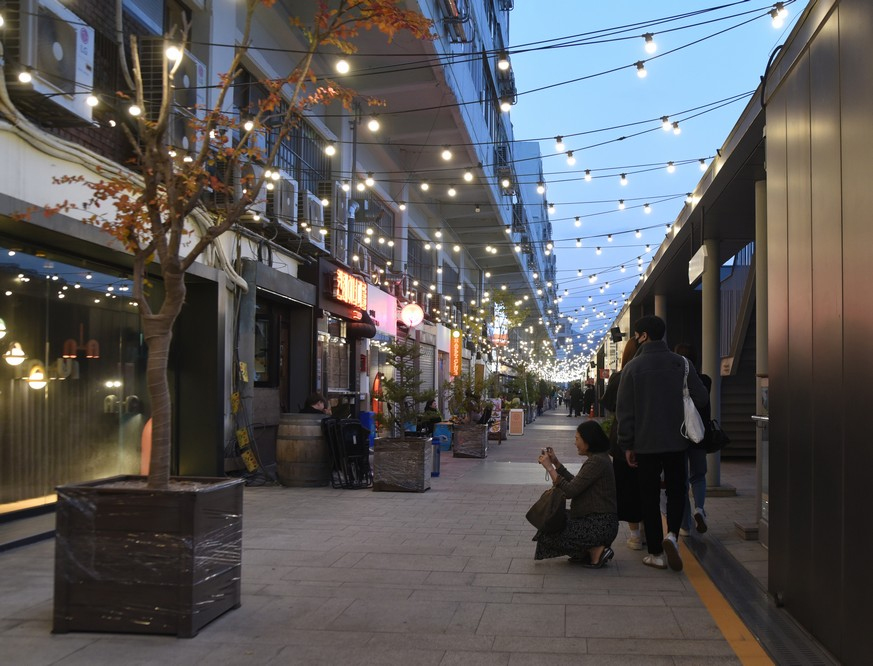[Apr] Aging megastructure gives way to burgeoning hipster culture
Date Apr 25, 2022
 Lights start to illuminate Sewoon Sangga’s third-floor plaza at dusk, October 2021.
Lights start to illuminate Sewoon Sangga’s third-floor plaza at dusk, October 2021.
What is Sewoon Sangga? The literal translation of its quintessential 1960s name is “Erecting Good Energy Shopping Mall.” As Seoul’s downtown core continues its breakneck development, Korea’s long-abandoned first urban megaproject has become the unlikely home to the capital’s young, hip crowd.
When Sewoon Sangga was built in 1967, it was intended to contain a self-sustained city, complete with housing, retail areas, various recreation facilities and workspaces for numerous industries. The site has been swept up into many political grand visions over the decades and is currently in the latter stages of a comprehensive regeneration project.
The land it’s built on is quite interesting: a kilometer-long, 50-meter wide strip that stretches from Jongmyo Shrine in the north to Namsan Mountain in the south. The land was originally cleared by imperial Japan. Authorities expected U.S. World War II bombers to extend their fire-bombing raids of Tokyo and other Japanese cities all the way to Seoul. After the Korean War, the old firebreak was settled by refugees and developed a reputation for poverty and seediness. To drive them out, the land was cleared once more during the Park Chung-hee administration to make way for Sewoon Sangga – something “promising a better, more prosperous future” as one reviewer put it.
When completed, Sewoon Sangga looked like an unstoppable convoy of super tankers and mega cruise ships cutting a path through the squalor of 1960s Seoul.
Each tower block was built by a different company, resulting in not only a slew of names, but also jarring differences in designs across the entire structure. The recent renovations call for two elevated second-floor walkways along either side for the full kilometer – even crossing the renovated Cheonggyecheon Stream. The original 1960s plan called for the third-floor terraces to make such a connection far above street level. But they remained apart for decades and vendors clogged the terraces with their wares. The gap between the two northernmost buildings has already been bridged, and the walkways are being extended southward to link up with the two buildings that are still left out.
Sewoon Sangga is a mix of restaurants, bars, music shops and bookstores started by young people striking out on their own as well as lingering remnants like the old-fashioned dabang (tea room/cafes), electronics shops and lush plant market.
The buildings, which were until recently quiet and uninviting after dark, are now home to a trendy outdoor promenade offering various food and drinks. On weekends, there’s sometimes a flea market selling retro items and handmade products on the footbridge stretching over Cheonggyecheon. Quite a remarkable transition has gripped the area, one that has continued throughout the pandemic, as Koreans are both nostalgic for the past and eager for the trendiest of experiences.
Parts of the structure are still not open to wanderers, particularly the upper residential floors. The roof of the northernmost building provided the public stunning views of the surrounding downtown core. Unfortunately, it has been closed in recent years due to the pandemic.
Many of the sprawling market’s visitors are attracted to the slowly vanishing traces of the Korea that was aggressively and quickly constructed during authoritarian governments, as well as the shady elements that later seeped into the complex. Sewoon Sangga provides a safe, authentic place to plug into a modern history that has produced unsightly images at times, but can still be a fun and meaningful place to inhabit.
**If you have any questions about this article, feel free to contact us at kocis@korea.kr.**

The Ministry of Culture, Sports and Tourism's "Korea Here & Now" work can be used under the condition of "Public Nuri Type 1 (Source Indication)."




